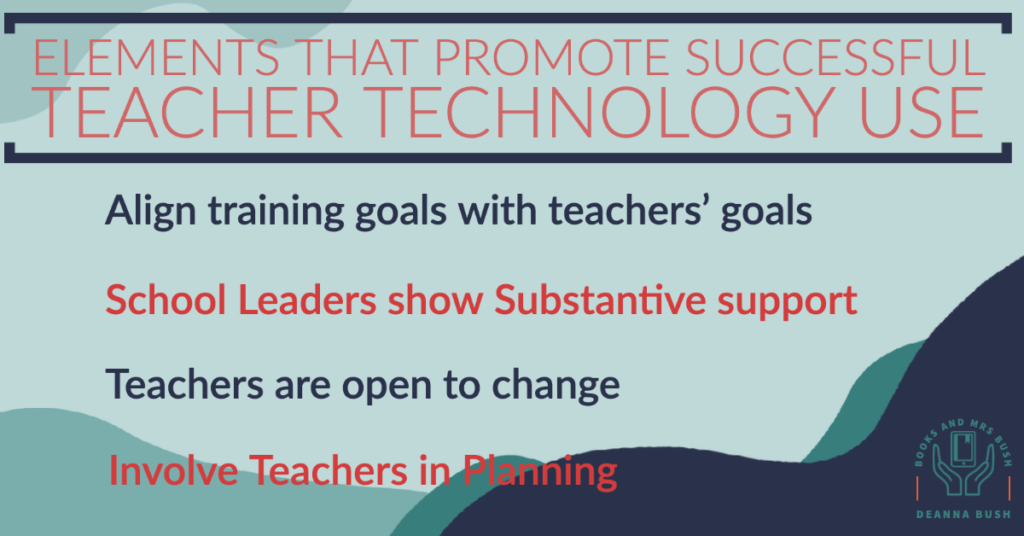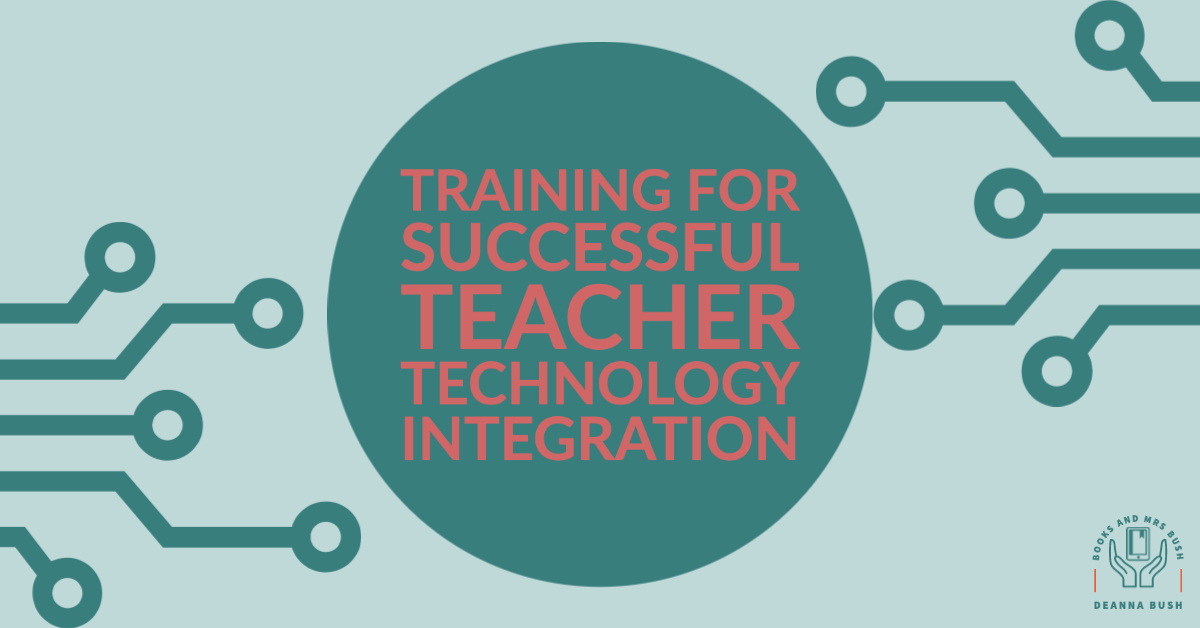4.5C: Evaluate the impact of professional learning and continually make improvements in order to meet the schoolwide vision for using technology for high-impact teaching and learning.
Educational technology presents a unique opportunity and challenge for educators. When designed and used well, technology can streamline some of the most time consuming aspects of education, engage students in learning, and increase opportunities for exploration. However, none of the positive aspects of educational technology are of any use if the technology gathers dust (virtual or otherwise) as it sits unused in our classrooms.
As part of ISTE 4.5C, education technology coaches have the responsibility to evaluate professional development and work to improve it in order to increase the effectiveness of teachers. In the same way that tools to support students sometimes sit forgotten in the darkness of their backpacks while the student continues to struggle along without them, educational technology trainers may find themselves watching teachers disengage from the technology and tools on which they’ve been trained soon after the training.
An examination of the organizational or peripheral elements within an ed tech professional development that result in greater implementation of and buy in from teacher attendees may help in making these programs more efficient and effective. The results of such an examination demonstrate that teachers and their motivations are complex. A 2020 study found that “teachers’ value and competence beliefs about technology integration are multidimensional constructs,” which do not lend themselves to simple solutions or results (Cheng, et al, 2020).
One peripheral element of ed tech professional development that has a direct impact on the success of implementation of the new technology is substantive administrative support and modeling of the adoption. In a 2002 study of 94 schools using Likert scale questioning, Baylor and Ritchie examined 15 factors that had the potential to predict the successful adoption of educational technology by teachers. Their study found that three variables were particularly important in the success of technology implementation in classrooms: “(1) the strength of technology leadership at a school; (2) teacher openness to change; and, (3) teacher non-school computer use” (Baylor & Ritchie, 2002).
Leadership Support
Strong technology leadership in a school may bring to mind initiatives from school leadership, active involvement from technology specialists, and funding for training, but Baylor and Ritchie saw technology leadership as specific to the daily actions of school leadership as they engaged in technology. Their study found a clear correlation between school leaders who promoted new technology, used the technology and built a culture of technology use and the successful implementation of that technology in the classroom (Baylor & Ritchie, 2002). It is not enough for administrators to provide verbal and financial support for technology use, to positively impact the implementation of new technology following a professional development, administrators must “actively use, model, and reward teachers who infuse technology into their classroom” (Baylor & Ritchie, 2002).
Aligned Goals
Another peripheral element that impacts the success of teacher training and professional development is whether the goals of the trainer and the teachers taking the training align. A 2012 study that examined pre-service teaching programs, found discrepancies in technology use and goals between teacher educators and pre-service teachers were sporadic but influenced the frequency of technology implementation of the teachers when they entered the classroom. In the study’s conclusion, the researchers recommended that “teacher education programs and teachers should form more partnerships to collaboratively work toward identifying and teaching the best methods for using technology to support teaching and learning” (Ottenbreit-Leftwich, 2012). Taking additional time to ensure alignment and partnership is one way to gain positive results in from trainings.
Openness to Change
There are additional factors that arise from teachers’ mindset and individual characteristics that influence their adoption of new technology tools. As Baylor and Ritchie explain, “Teachers who are open to change, whether this change is imposed by administrators or as a result of self-exploration, appear to easily adopt technologies to help students learn content and increase their higher-level thinking skills” (2002). This characteristic of approaching new initiatives and tools with an open mind can be ingrained or cultivated through the development of a culture that promotes openness to change within the training itself, the school or district. The U.S. Department of education also observes that all stakeholders in education will need to be open to the sifting environment of educational technology use (2017), which can be encouraged through an environment that promotes teacher openness to change.
Teacher Involvement from the Start
Another element of successful adoption of educational technology following a training requires changes that occur long before the training begins: inclusion of classroom educators from the beginning of technology and training development. Baylor and Ritchie found in a study that “long-range planning for software developers and schools of education should include a vision that nurtures decision-making and development by teachers, rather than implementing systems solely from the level of policymakers” (2002). The U.S. Department of Education also emphasizes the importance of a “shared vision for how technology best can meet the needs of all learners” in its National Education Technology Plan (2017).
This element requires turning the typical method of technology tool adoption and training upside-down. Instead of adopting a technology prior to training staff, districts and technology creators begin the process by meeting with educators and including them in the development or technology adoption process. Then, once the technology is ready for use, training teachers occurs. Classroom teachers are involved in all aspects of the process, and their implementation of the technology arises from this involvement.

It is in school district and professional development provider’s best interest to improve the buy in and adoption from teachers because it causes a ripple effect that results in beneficial changes more widespread than the specific technology in the professional development. Baylor and Ritchie state that the act of incorporating the new technology in their classroom causes an increase in their overall technical competence and morale (2002). This illustrates the importance of developing effective teacher technology training that includes addressing and adjusting peripheral elements that increase the likelihood that this training will result in technology implementation in the classroom.
Resources
Baylor, A. L., & Ritchie, D. (2002). What factors facilitate teacher skill, teacher morale, and perceived student learning in technology-using classrooms? Computers & Education, 39(4), 395. https://doi-org.ezproxy.spu.edu/10.1016/S0360-1315(02)00075-1
Cheng, S.-L., Lu, L., Xie, K., & Vongkulluksn, V. W. (2020). Understanding teacher technology integration from expectancy-value perspectives. Teaching & Teacher Education, 91, N.PAG. https://doi-org.ezproxy.spu.edu/10.1016/j.tate.2020.103062
Ottenbreit-Leftwich, A. T., Brush, T. A., Strycker, J., Gronseth, S., Roman, T., Abaci, S., vanLeusen, P., Shin, S., Easterling, W., & Plucker, J. (2012). Preparation versus practice: How do teacher education programs and practicing teachers align in their use of technology to support teaching and learning? Computers & Education, 59(2), 399–411. https://doi-org.ezproxy.spu.edu/10.1016/j.compedu.2012.01.014
U.S. Department of Education. (2017, January 18). Introduction. Office of Educational Technology. https://tech.ed.gov/netp/introduction/

Good post, Deanna! I think what I noticed most is your last point in the graphic, “involve teachers in planning.” Buy-in is indeed important for acceptance, but involving teachers is key to feeling more of a sense of inclusion versus something being passed down. Interesting topic of conversation.
Deanna, as I was reading through your blog I kept reflecting back on a wonderful experience of building-level PD. I was able to clearly connect examples from that positive experience to the 4 elements you call out in post and summarize in your graphic. One element I currently struggle with in my role as a TOSA is teachers’ openness to change. I’m thinking about ways to involve teachers from across my district in order to design large-scale PD in hopes that it may also support openness to change. Your post has encouraged me to be very reflective about my practice and I appreciate you sharing this!